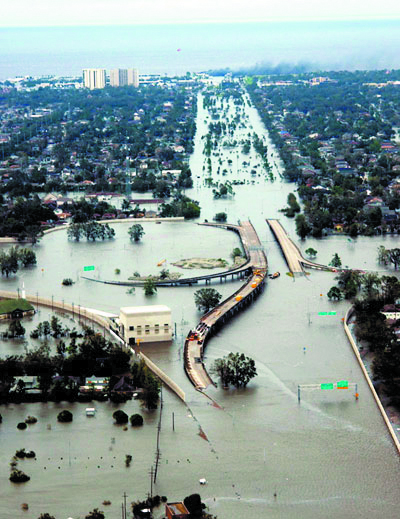Sunday, Aug. 29, marks the fifth-year anniversary of what the National Oceanic and Atmospheric Administration (NOAA) described as the most destructive hurricane, economically, in the United States.
It boasted a Category 5 level in the Gulf of Mexico, packing winds of 175 miles per hour. It slammed into the Louisiana coastline as a strong Category 3. Its horrific impact caused massive flooding in New Orleans as its powerful force broke the city’s levies.
The Mississippi Coast was also crushed by its winds that caused towering surges and flooding. NOAA figures indicate that Hurricane Katrina killed a total 1,836 people across Louisiana, Mississippi, Alabama and Georgia.
“New Orleans looked like a ghost town,” said Janie Hicks, a former resident, as she reflected on he horrors of Katrina and the “chaotic” evacuation.
Hicks, who was a 13-year resident of the “crescent city” fled to Jackson, Miss., the place of her birth, where resides today. “They did not have to beg me to evacuate,” she said. Hicks is program associate for the Southern Regional Children’s Defense Fund, based in Jackson.
CDF National President Marian Wright Edelman, Southern Regional Children’s Defense Fund Director Oleta Fitzgerald and staff, will join CDF’s Katrina Citizens Leadership Corps (KCLC), the Louisiana Justice Institute, Congressional leaders and others in New Orleans Thursday through Sunday for a weekend of advocacy in the fight to make sure children are not left out in the federal handling of other Katrina-like disasters.
KCLC is calling for amendments to The Robert T. Stafford Disaster Relief and Emergency Assistance Act (Stafford Act). It is a federal law designed to bring an orderly and system-wide means of federal natural disaster assistance for state and local governments in carrying out their responsibilities to aid citizens.
According to KCLC data, the act which is used by FEMA, failed not only families, but the children particularly.
Reports indicated that Katrina caused the displacement of about 200,000 children from the Gulf Region.
“The Stafford has more provisions for animal shelters during times of disaster than it does for children,” said Fitzgerald. “Daycare centers were not FEMA covered expenses under this act. There was nothing in place where children’s benefits could follow them. For example, a child’s Louisiana CHIP card didn’t work in Mississippi. What we are doing is making sure children don’t fall through the crack.”
Fitzgerald also pointed out that the government had more processes in place for getting people evacuated from New Orleans than there were processes of getting them back to the city.
She said five years later, there are still thousands of New Orleanians who are have not returned since Katrina.
The Mississippi Link talked to native New Orleanian Larry Jordan, who did return, but who also concurs that thousands of his fellow natives are not back.
“The city itself hasn’t bounced back the way it could,” he said. “Charity Hospital never reopened. It was the place poor people could go to get health care, even when they did not have insurance. See, it was not just a hospital; it had a lot of clinics.”
He said the Lower 9th Ward, the hardest hit area, has not seen much improvement at all.
Jordan said the people were depending on the government when Katrina hit, and five years later they are still depending on the government.
Both Hicks and Jordan agree that people have not returned, for the most part, because the cost of living now is so high in New Orleans. Although she does not plan to return to live, Hicks said she is “sad that many people who want to return can’t afford the increase in rent and the low-paying service jobs.”
Jordan said, in his opinion, the Road Home Program has not helped as much as it promised.
In an article posted on the Louisiana Justice Institute website written by Bill Quigley, Davia Finger and Lance Hill earlier this month stated the following about the condition of New Orleans today:
“Five years after Katrina, tens of thousands of homes in New Orleans remain vacant or blighted. Tens of thousands of African American children who were in the public schools have not made it back, nor have their parents. New Orleans has lost at least 100,000 people. Thousands of elderly and disabled people have not made it back. Affordable housing is not readily available, so tens of thousands pay rents that are out of proportion to their wages. Race and gender remain excellent indicators of who is underpaid, who is a renter, who is in public school and who is low income.”
Jordan said, “Other areas like the Mississippi coast and Galveston, Texas have faired better than we have in the rebuilding process. It is evident that there is a whole lot of government bureaucracy [state and federal] holding things up for us.”
KCLC hopes their recommendations and what they plan to do in New Orleans this weekend will cause a “shift in the paradigm on how the government responds to disasters” in the future.


Be the first to comment